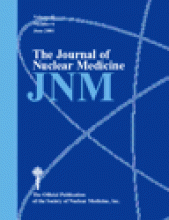In this issue of The Journal of Nuclear Medicine, Rutar et al. (1) describe a very practical study in which the authors monitored the exposure of family members of patients released after receiving 131I-anti-B1 antibody therapy. In the recently amended rulings by the Nuclear Regulatory Commission (NRC), patient release criteria were expanded from the traditional activity-based limit to include activity and dose-based criteria. The old activity-based limit of 1.11 GBq (30 mCi) was originally intended to apply only to patients receiving 131I-NaI for therapy but, in the absence of other guidance, was applied to the release of patients receiving various therapeutic agents. As stated by the authors, “The dose-based limit better expresses the primary concern of the NRC for public health and safety,” and this limit is clearly more reasonable scientifically.
The authors have actually accomplished 2 tasks with this article: for a specific compound, they have given exposure data showing that actual doses to patients were within NRC guidelines in the population studied, and they also have shown, by example, how data can be gathered for other agents. Their modification of Equation 2 to produce Equation 5 (including more specific treatment of bladder-voiding patterns expected for this agent) shows a technique for further tailoring the method to specific radiopharmaceuticals. An absence of real data is what usually leads to ineffective guidance from federal authorities or other advisory or regulatory bodies. Uncertainty almost always leads to overconservatism, which is arguably not always in the best interests of the patients and their families (e.g., leading to longer hospital stays). The authors show that good data, which can shape future guidance or regulations, can be gathered without a terribly labor-intensive effort and that relatively uniform results can be obtained—the measured values were regularly lower than model-predicted values.
It is said that all models are wrong, but some are useful. Even in the new NRC rulings, the model used in the activity-based equation is quite conservative—the source of activity is treated as a point source with no attenuation. More extensive modeling can be done using Monte Carlo simulations with more complicated sources, but what is problematic is the description of the time–motion relationships between the source and the target: people stand up and sit down, cook dinner and take walks together, and do many other things that cannot be modeled effectively in a computer simulation. Even in the dose-based approach, simplified values of occupancy and distance values are applied. Therefore, measured data, if available, are clearly to be preferred for decision making.
Except in cases 14 and 15, which involved badging of multiple individuals, Equation 5 did the best job of predicting the measured doses, but the measured doses were very consistently lower than predicted by Equation 5 (21 of 22 patients). In all patients, the measured values were within the NRC dose limits, thus supporting the authors’ claim that it is generally safe to release patients with this drug using the NRC method. In one patient (patient 11), the measured dose was higher than 2 of the 3 values predicted by the model (but again still within NRC dose limits). This finding suggests that some outliers can occur and that it may be prudent to apply a margin of safety in releasing patients if the calculated doses are near the limit. The use of patient-specific data in dose calculations will almost always improve the accuracy of model predictions. The NRC model has 2 patient-specific components (the administered activity and effective half-time for clearance from the patient’s body) that allow specific calculations in each case. However, in the final analysis, models are only models, and specific habits of particular individuals will vary and will determine what doses are received. Obviously, we cannot make measurements for every patient, but if a reasonable body of data is gathered on a representative population, as was done here, confidence can be gained that the model predictions will be reliable for most patients, and prudence can be applied in borderline situations.
In overview, the nuclear medicine community is well served by the new release criteria as a replacement for the previous one-size-fits-all approach. Rutar et al. (1) have shown how such guidance can be applied effectively to the study of individual therapeutic agents, and other investigators should follow their example and produce similar data for other agents. If such a body of data can be accumulated, future guidance and practice can only improve.
Footnotes
Received Oct. 11, 2000; revision accepted Oct. 13, 2000.
For correspondence contact: Michael G. Stabin, PhD, Department of Radiology and Radiological Sciences, Vanderbilt University Medical Center, 1161 21st Ave. S., Nashville, TN 37232-2675.







